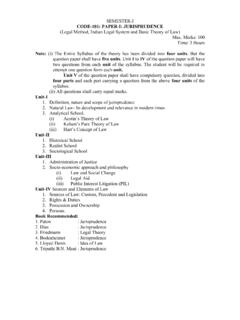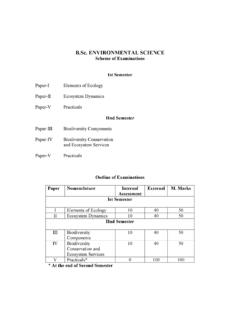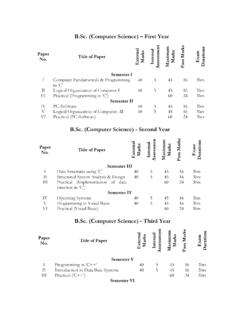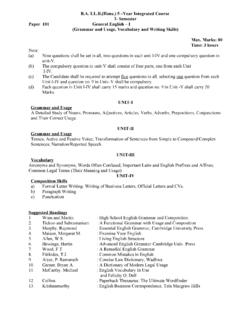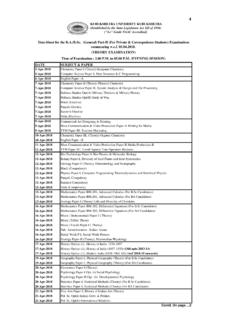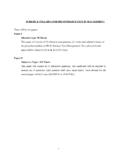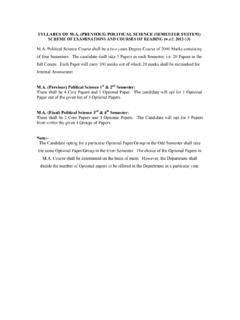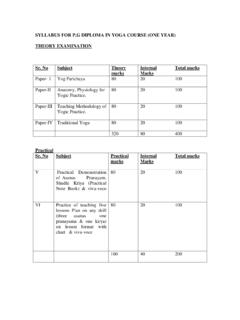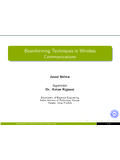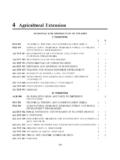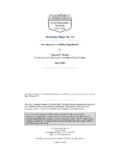Transcription of SCHEME OF EXAMINATION OF B. Sc. (MEDICAL) …
1 UPDATED SCHEME OF EXAMS. & SYLLABI FOR OF EXAMINATION OF B. Sc. ( medical )BOTANYS emester IPaper IDiversity of MicrobesMax Marks- 40+10 Time-3 BiologyMax Marks- 40+10 Time-3 IIPaper-IDiversity of ArchegoniatesMax Marks- 40+10 Time-3 Marks- 40+10 Time-3 (Annually)Semester-I&IIMax Marks- 80+20 Time-6 Hrs. (Two Sessions)Semester-IIIP aper-IBiology and Diversity of Seed Max Marks- 40+10 Time- 3 AnatomyMax Marks- 40+10 Time-3 and Diversity of Seed Max Marks- 40+10 Time- 3 HrsPlants-IIPaper-IIPlant EmbryologyMax Marks- 40+10 Time- 3 (Annually)Max Marks- 80+20 Time- 6 & IV (Two sessions)Semester-VPaper-IPlant PhysiologyMax Marks- 40+10 Time 3 HrsPaper-IIEcologyMax Marks- 40+10 Time 3 & Plant BiotechnologyMax Marks - 40+10 Time-3 HrsPaper-IIEconomic BotanyMax Marks - 40+10 Time 3 (Annually)Max Marks - 80+20 Time- 6 HrsSemester-V & VI(Two Sessions) Total Marks 900*20% marks allotted for Internal Marks 40+10 Time- 3 IDIVERSITY OF MICROBESNote.
2 Attempt five questions in all, selecting two questions from each unit. Question No. 1 is compulsory (short answer type).Nine questions are to be set spread over the entire syllabus. All questions carry equal : Structure, nutrition, reproduction and economic importance; general account of cyanobacteria (with reference to Nostoc).Algae: General characters, classification (upto classes) and economic importance; important features and life-history (excluding development) of Volvox, Oedogonium (Chlorophyceae), Vaucheria (Xanthophyceae), Ectocrpus (Phaeophyceae) and Polysiphonia (Rhodophyceae).UNIT-IIViruses: General account of Viruses including structure of TMV and : General characters, classification (upto classes) and economic importance; important features and life-history of Phytophthora (Mastigomycotina), Mucor (Zygomycotina), Penicillium (Ascomycotina), Puccinia, Agaricus (Basidiomycotina), Colletotrichum (Deuteromycotina); General account of IICELL BIOLOGYMax.
3 Marks - 40+10 Time- 3 :Attempt five questions in all, selecting two questions from each unit. Question No. 1 is compulsory (short answer type).Nine questions are to be set spread over the entire syllabus. All questions carry equal Cell Envelopes: Structure and functions of Cell Wall and Plasma Membrane. Ultrastructure and function of nucleus, Golgi Apparatus, Endoplasmic Reticulum, Chloroplast, Mitochondria, Lysosomes, Peroxisomes and Division: Mitosis and : Morphology, organization, ultrastructure of Centromere and Telomere; Chromosomal alterations- deletions, duplications, translocations, inversions; Variations in chromosome number- aneuploidy, polyploidy; sex chromosomes and sex READINGSS mith, 1971. Cryptogamic botany .
4 Algae & Fungi. Tata McGraw Hill Publishing Co., New , 1991. The Fungi. Rastogi & Co., , 1990. An Introduction to Fungi, Vikas Publishing House , , A. 1958. Introduction to the Bacteria: McGraw Hill & Co., New , , , J., Raff, , Roberts, K. and Watson. 1999. Molecular Biology of Cell. Garland Publishing Co., Inc., New York, , Girton, and McDonald, 1999. The Science of Genetics, Saunders College Publising , Fort Worth, , 1999. A text book of Cell and Molelcular Biology. Rastogi Publications, Meerut, , L. J and Kish, 1995. Principles of Cell and Molecular Biology (2nd edition) Harper Collins College Publishers, New York, , H., Berk, A., Zipursky, , Matsudaria, P., Baltimoe, D. and Darnell, J. 2000. Molecular, Cell Biology, Freeman and Co.
5 , New York., , 1998. Genetics, The Benjamin/Cummings Publishing Co. Inc., , and Simmons, 2000. Principles of Genetics. John Wiley and Sons, Inc. USA. SEMESTER-IIMax. Marks - 40+10 Time- 3 IDIVERSITY OF ARCHEGONIATESNote:Attempt five questions in all, selecting two questions from each unit. Question No. 1 is compulsory (short answer type).Nine questions are to be set spread over the entire syllabus. All questions carry equal General characters, classification (upto classes), alternation of generations, structure and reproduction (excluding development) of Marchantia (Hepaticopsida), Anthoceros (Anthocerotopsida), Funaria (Bryopsida).UNIT-IIPteridophyta- General characters, classification (upto classes), alternation of generations, structure and reproduction (excluding development) of Rhynia (Psilopsida), Selaginella (Lycopsida), Equisetum (Sphenopsida) and Pteris (Pteropsida).
6 PAPER IIGENETICSMax. Marks - 40+10 Time- 3 :Attempt five questions in all, selecting two questions from each unit. Question No. 1 is compulsory (short answer type).Nine questions are to be set spread over the entire syllabus. All questions carry equal Material: DNA the genetic material, DNA structure and replication, DNA-Protein interaction, the Nucleosome Model, Genetic Code, Satellite and Repetitive Inheritance: Mendelism: Laws of segregation and Independent Assortment; Linkage Analysis; Allelic and non-allelic interactions. UNIT-IIGenetic Variations: Mutations- spontaneous and induced; transposable genetic elements; DNA damage and Expression: Modern concept of gene; RNA; Ribosomes; transfer of genetic information- transcription and translation (Protein Synthesis); regulation of gene expression in prokaryotes and eukaryotes; 1-D, 2-D and 3-D structure of Nuclear Inheritance: Presence and function of Mitochondrial and Plastid DNA; READINGS:Atherly, Girton, and McDonald, 1999.
7 The Science of Genetics, Saunders College Publishing, Fort Worth, , 1999. A text book of Cell and Molecular Biology. Rastogi Publications, Meerut, IndiaKleinsmith, and Kish, 1995. Principles of Cell and Molelcular Biology (2nd edition). Harper Collins College Publishers, New York, , H., Berk, A., Zipursky, , Matudaria, P., Baltimoe, D. and Darnell, J. 2000. Molecular, Cell Biology, Freeman and Co., New York, , 1998. Genetics, The Benjamin/Cummings Publishing Co. Inc., , and Simmons, 2000. Principles of Genetics. John Wiley and Sons, Inc. , 1971. Cryptogamic botany , , Bryophytes & Pteridophytes. Tata McGraw Hill Publishing Co., New , 1992. Text Book of Thallophytes, McGraw Hill Publishing , 1990. Text Book of Pteridophyta, Mc Millan India , P.
8 , 1980, Bryophyta, Atma Ram & Sons, Delhi. PAPER IIIPRACTICALSMax. Marks -80+20*Time- 6 Hrs. (2 Sessions) , classify and write short morphological notes giving well labelled relevant26diagrams on the given specimens A, B, C and D (one each from Algae, Fungi,Bryophytes and Pteridophytes). the root smear and find out two different stages of Mitosis. Identify10and show it to the examiners. Also give characters of regarding Genetics (Mendelian Inheritance or Gene Interaction) as per giving two important characters of identification on spots 1, 2, 3 and 4 (one material each from Algae, Fungi, Bryophytes and Pteridophytes). , collection and collection OF PRACTICALS (Semester I & II) of Mitosis from Material (Onion-root tips).
9 On Monohybrid and Dihybrid Interactions and modified Dihybrid study- Specimens from Algae, Fungi, Bryophytes and Pteridophytes as per theory tour of an area rich in diversity of Archegoniates for collection of plants, plant diseases and preparation of of Survey/Collection Report. B. Sc. II ( botany ) SyllabusSEMESTER-IIIMax. Marks 40+10*Time- 3 IBIOLOGY AND DIVERSITY OF SEED PLANTS-INote:Attempt five questions in all, selecting two questions from each unit. Question No. 1 is compulsory (short answer type).Nine questions are to be set spread over the entire syllabus. All questions carry equal IGeneral characters and diversity of Gymnosperms (seed plants without fruits).Pilger and Melchior's (1954) system of Time Table; Evolution of Seed and Fossilization (Processes involved, types of Fossils and Importance of Fossils; Reconstruction of the following fossil plants: LyginopterisWilliamsoniaCycadeoidea (=Bennettites).)
10 UNIT- IIMorphology and anatomy of root, stem leaf/leaflet and reproductive parts including mode of reproduction, life-cycle and economic importance of the following:CycasPinusEphedraGeneral characters of Angiosperms including primitive angiosperms (Amentiferae, Ranales, Magnoliales).PAPER IIPLANT ANATOMYMax. Marks 40+10*Time- 3 :Attempt five questions in all, selecting two questions from each unit. Question No. 1 is compulsory (short answer type).Nine questions are to be set spread over the entire syllabus. All questions carry equal in plant forms-annuals, biennials and and permanent (simple and complex).The Shoot system-shoot apical meristem and its histological organizations (monocot and dicot stem); Cambium-structure and growth in dicot stem; characteristics of growth rings; sap wood and heart wood, periderm; Anomalous secondary growth (Dracaena, Boerhaavia and Achyranthes)UNIT-IILeaf-Types of leaves (simple and compound); and multiseriate, epidermal appendages and their morphological of typical Monocot and Dicot leaf and cell inclusions in leaves; leaf abscission.
